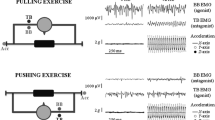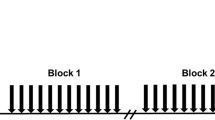Abstract
As a result of intrafusal thixotropy, muscle contraction at a short length followed by passive lengthening enhances the subsequent tonic vibration reflex (TVR). We studied the effects of muscle vibration, contraction, and their combination on the subsequent TVR in the left biceps in 20 healthy men. The preceding vibration (20 or 80 Hz) conditioning at a short or long length was applied to the muscle belly with and without a contraction. After conditioning, distal tendon vibration (80 Hz) was used to elicit the TVR at the test length. The strength of the TVR was measured by surface electromyography. Conditioning with 80-Hz vibration at a short length followed by passive lengthening enhanced the subsequent TVR, which was greater in the presence than in the absence of a conditioning contraction. These results suggest that vibration and contraction work synergistically to develop intrafusal thixotropy.




Similar content being viewed by others
References
Burke D, Gandevia SC (1995) The human muscle spindle and its fusimotor control. In: Ferrell W, Proske U (eds) Neural control of movement. Plenum Press, New York, pp 19–25
Burke D, Hagbarth KE, Lofstedt L, Wallin BG (1976) The responses of human muscle spindle endings to vibration of non-contracting muscles. J Physiol 261:673–693
Campbell KS, Lakie M (1998) A cross-bridge mechanism can explain the thixotropic short-range elastic component of relaxed frog skeletal muscle. J Physiol 510:941–962
Eklund G, Hagbarth KE (1966) Normal variability of tonic vibration reflexes in man. Exp Neurol 16:80–92
Eklund G, Hagbarth KE, Hagglund JV, Wallin EU (1982) The ‘late’ reflex responses to muscle stretch: the ‘resonance hypothesis’ versus the ‘long-loop hypothesis’. J Physiol 326:79–90
Enoka RM, Hutton RS, Eldred E (1980) Changes in excitability of tendon tap and Hoffmann reflexes following voluntary contractions. Electroencephalogr Clin Neurophysiol 48:664–672
Gilhodes JC, Gurfinkel VS, Roll JP (1992) Role of Ia muscle spindle afferents in post-contraction and post-vibration motor effect genesis. Neurosci Lett 135:247–251
Gooey K, Bradfield O, Talbot J, Morgan DL, Proske U (2000) Effects of body orientation, load and vibration on sensing position and movement at the human elbow joint. Exp Brain Res 133:340–348
Gregory JE, Morgan DL, Proske U (1988) Aftereffects in the responses of cat muscle spindles and errors of limb position sense in man. J Neurophysiol 59:1220–1230
Gregory JE, Wise AK, Wood SA, Prochazka A, Proske U (1998) Muscle history, fusimotor activity and the human stretch reflex. J Physiol 513:927–934
Hagbarth KE, Hagglund JV, Nordin M, Wallin EU (1985) Thixotropic behaviour of human finger flexor muscles with accompanying changes in spindle and reflex responses to stretch. J Physiol 368:323–342
Hagbarth KE, Nordin M (1998) Postural after-contractions in man attributed to muscle spindle thixotropy. J Physiol 506:875–883
Hill DK (1968) Tension due to interaction between the sliding filaments in resting striated muscle. The effect of stimulation. J Physiol 199:637–684
Hutton RS, Suzuki S (1979) Postcontraction discharge of motor neurons in spinal animals. Exp Neurol 64:567–578
Hyngstrom AS, Johnson MD, Miller JF, Heckman CJ (2007) Intrinsic electrical properties of spinal motoneurons vary with joint angle. Nat Neurosci 10:363–369
Ishihara Y, Izumizaki M, Atsumi T, Homma I (2004) Aftereffects of mechanical vibration and muscle contraction on limb position-sense. Muscle Nerve 30:486–492
Kiehn O, Eken T (1997) Prolonged firing in motor units: evidence of plateau potentials in human motoneurons? J Neurophysiol 78:3061–3068
Morgan DL, Proske U, Gregory JE (1991) Responses of primary endings of cat muscle spindles to locally applied vibration. Exp Brain Res 87:530–536
Nordin M, Hagbarth KE (1996) Effects of preceding movements and contractions on the tonic vibration reflex of human finger extensor muscles. Acta Physiol Scand 156:435–440
Proske U, Gregory JE (1999) Vibration sensitivity of cat muscle spindles at short muscle lengths. Exp Brain Res 124:166–172
Proske U, Morgan DL, Gregory JE (1992) Muscle history dependence of responses to stretch of primary and secondary endings of cat soleus muscle spindles. J Physiol 445:81–95
Proske U, Morgan DL, Gregory JE (1993) Thixotropy in skeletal muscle and in muscle spindles: a review. Prog Neurobiol 41:705–721
Proske U, Wise AK, Gregory JE (2000) The role of muscle receptors in the detection of movements. Prog Neurobiol 60:85–96
Roll JP, Vedel JP, Ribot E (1989) Alteration of proprioceptive messages induced by tendon vibration in man: a microneurographic study. Exp Brain Res 76:213–222
Sapirstein M, Herman R, Wallace G (1937) A study of after-contraction. Am J Physiol 119:549–561
Sekihara C, Izumizaki M, Yasuda T, Nakajima T, Atsumi T, Homma I (2007) Effect of cooling on thixotropic position-sense error in human biceps muscle. Muscle Nerve 35:781–787
Steyvers M, Levin O, Verschueren SM, Swinnen SP (2003) Frequency-dependent effects of muscle tendon vibration on corticospinal excitability: a TMS study. Exp Brain Res 151:9–14
Whitehead NP, Gregory JE, Morgan DL, Proske U (2001) Passive mechanical properties of the medial gastrocnemius muscle of the cat. J Physiol 536:893–903
Yasuda T, Izumizaki M, Ishihara Y, Sekihara C, Atsumi T, Homma I (2006) Effect of quadriceps contraction on upper limb position sense errors in humans. Eur J Appl Physiol 96:511–516
Acknowledgments
We thank Dr. Uwe Proske for reviewing the manuscript.
Author information
Authors and Affiliations
Corresponding author
Rights and permissions
About this article
Cite this article
Nakajima, T., Izumizaki, M., Sekihara, C. et al. Combined effects of preceding muscle vibration and contraction on the tonic vibration reflex. Exp Brain Res 192, 211–219 (2009). https://doi.org/10.1007/s00221-008-1571-x
Received:
Accepted:
Published:
Issue Date:
DOI: https://doi.org/10.1007/s00221-008-1571-x




